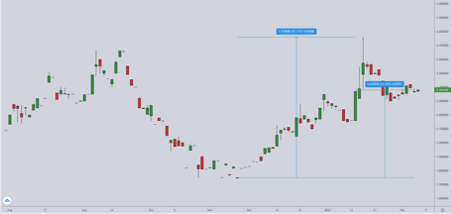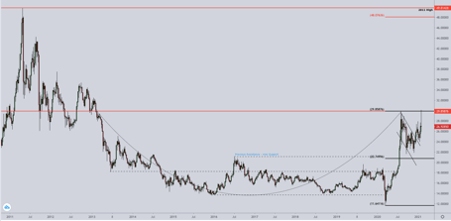The Great Silver Story : If you hold a Silver coin in your hand you are instantly struck by the weight of the object. The ultra-smooth metal slides effortlessly across your fingers and in the light of day, your eyes catch the glint of the reflected sun. It is very hard not to smile when you are up close and personal with ‘Real Money’.
The Great Silver Story
There is a very human connection to Silver spanning 6000 years which means we all intuitively agree, that when it comes to the end game we’re all going to accept a precious metal as real money, over anything conjured up by a government.
Over the last 365 days, a lot has happened to the health of the world’s population and economies. Global leaders would have us believe that the Spring of 2020 was a great opportunity to ‘reset the system’ and ‘build back better’, using new ways, ideas, and improved systems to benefit all of humanity, not just the 1%.
“opportunity of a lifetime”.
In reality, a re-hashing of an old and failed system is inevitable, but for some, the great reset did occur, and it was one which until recently was largely overlooked. The potential buying opportunity of a lifetime occurred when Silver traded down to $12.
After the COVID-19 pandemic financial crash which bottomed in March 2020, there has been a lot of commentary on the reflation trade. When the world feels like it has metaphorically stopped turning, everything has to reset. Our personal views are reconsidered and we’re all vulnerable to manipulation when everything looks its bleakest.
We were all forced to look around at globalisation and consider the pros and cons of what happens when global supply chains break down. We were left wondering whether the financial system would come to a halt and if so, what chaos would ensue.
Ordinary people looked to governments and central banks to make the correct decisions, to protect their personal health and livelihoods. The subsequent recovery appeared to start with returning investor confidence and their willingness to buy back into the markets but in reality, the investors have one eye firmly on the sentiment of the populous who in turn need confidence that when they return to work, they will be safe.
The Fundamentals The Great Silver Story
With economic reflation being stimulated by trillions from central banks across the globe, the balance between what is needed and what is best for the economies started to be weighed. The Central Banks gave investors the confidence that monetary policy would backstop the markets and we saw U.S. indices at all-time highs following a V-Shape recovery, but what about inflation? Gold and Silver are sensitive to inflation as can be seen by the inverse relationship between them and U.S. 10 Year Treasury yields.
And there have actually been some signs of inflation coming back into the markets but considering we started from zero in the wake of the global shutdown some inflation was inevitable.
The Great Silver Story – The mainstream narrative believes recent CPI and PCE readings show an increase in inflation and the price of Silver has tracked the recent rise in PCE, but the Fed is not convinced that inflation is coming back before 2022, even if they state that they are willing to let the inflation rise above the 2% intended target.
If you look to the money multiplier any signs of monetary inflation are short-lived and disinflationary pressures are here already. So, if Silver and Gold are rising against disinflationary pressures the mainstream narrative must be mistaken.
Some of the most dramatic moves in the markets have boiled down to the access or lack thereof, to high-grade collateral. Banks, hedge funds, and primary dealers need to fund trades in the overnight markets and in doing so need to put up collateral against their positions. This high-grade collateral usually comes in the form of US Treasuries but there are increasingly more instances where positions get margin called or the banking system has a credit crunch, resulting in a need for these big market participants to find liquid cash fast.
We saw the results of these large market participant’s actions in the early stages of the Covid-19 crash, where the market not only saw impending doom but needed to sell their most liquid assets.
The narrative that precious metals are a hedge against the increase in inflation makes sense when you consider the purchasing power of a US dollar today compared to a year ago, or a decade ago and more so if you look back a hundred years. But in reality, investors are looking to precious metals like silver because they have a lack of confidence in the central bank’s abilities to do anything tangible to sustain a healthy economy. The tried and tested Quantitative Easing model has been proven to stagnate an economy for decades, we only have to look to Japan for empirical evidence. Why should doing a bigger or more sustained version of that produce different results this time?
Increased Volatility Great Silver Story
Market crashes are volatility events and when the word volatility is used, some see it as a problem and others as an opportunity. Silver has an interesting relationship with volatility when compared to an asset like Gold due to the size differential between the two markets and their different supply and demand pressures. The volatility seen at the trough in the precious metals market during 2020 ensured that the upside potential was for those willing to invest when the markets looked to be at their worst.
Silver also comes with connotations of a manipulated market which can be enough to put less-informed investors off. The recent manipulations of Silver came on the back of retail sentiment towards massive institutional short selling against some meme stocks and the idea that retail traders could short squeeze an overleveraged position held by a hedge fund or bank, as per the case of Gamestop (GME) and Melvin Capital LLP. After some comparable David and Goliath move against the hedge funds the retail traders looked to add to their scalps and turned their attention to the infamous short selling positions against Silver.
Why did silver spike in 1979?
One Reddit forum post stated that the retail traders could take on the likes of JP Morgan Chase who have been known to be heavily short the Silver derivatives market following on from their absorption of Bear Sterns during the ‘Great Financial Crash’. What was not stated in the Reddit post was that JP Morgan Chase also owns 50% of the physical market sat at the COMEX, so squeezing their short paper position would be offset by the massive physical position. The resulting media attention and influx in trading volume saw a pump in Silver prices to just over $30 but this was short-lived and was nowhere near the comparison the media used with the Hunt Brothers in the 1980s.
Supply and Demand are the reasons why assets have a sustained fall or rise, and in recent months and weeks, the demand for Silver has been steadily rising. Massive inflows of money into ETFs like $SLV since 2020 have been unprecedented and that has resulted in increased institutional buying of physical commercial bars. At the same time retail dealers have been cleaned out, so getting your hand on physical silver of the smaller denominations has become extremely hard, with several weeks between purchase and delivery. The premium spreads between commercial and retail have risen, indicating an increasingly illiquid market, and considering there has been a mining deficit the added demand and decrease in supply is the best base-case scenario for a more prolonged rise in the Silver market.
Other macro themes that support the increasing demand scenario is from the ‘New Green Deal’ to fight climate change, being actively promoted by the new U.S. administration, as green technologies use an increased amount of Silver. The market comparison could be akin to what happened to Palladium, which has seen a sustained rise in prices due to the balance of greater demand in that commodity.
The Trade (The Great Silver Story)
So how do you get in on a Silver trade if the best time to buy was some time ago and you don’t have $10,000 to buy a commercial bar of Silver? You could look to buy on the dips in XAGUSD and it is always advisable to buy small amounts of physical and invest regularly, as holding some 10% of your portfolio in Silver over many years will help maintain your personal wealth when considering the purchasing power of a U.S. dollar.
You could look to the mining companies as they are relatively cheap, but a better way would be through the purchase of shares in a royalty company also known as a streaming company. These companies are the angel investors to mining companies and provide a financing service in return for royalties on the mine’s production output and one of the key benefits to owning royalty companies is that they have consistently outperformed other mining equities over the past 10 years.
Figure 4 VOX Royalty
One such play is VOX Royalty which listed on the TSX last year and has seen a 35% growth in share price since November 2020. Vox Royalty has been trading since 2014 but went public in May 2020, with a focus on precious metals within safe geopolitical markets such as Australia, Canada, and the USA. Their management team consists of mining engineers and geologists and collectively they come with 40 years of experience within the industry. Their technical prowess and intellectual property rights put them head and shoulders above any other new entrants to the competitive royalty space and they are currently the most active through their acquisitions which are heavily focused on increased growth with value assets. With over 7000 strategic royalties and mines within their proprietary database, the opportunities for further exponential growth and acquisitions are sizeable and their largest royalty to date is within Australia’s largest silver and gold mine.
Figure 5 XAG/USD
During more volatile times the royalty companies fair better because they set fixed prices at fair value and well below market, ensuring a favourable spread between the streaming agreements and spot price. Looking at the XAGUSD chart on a weekly time frame $19.50 to $20.50 is a good level of support being that it is 50% of the range from the 2020 low to the recent swing highs and also previous resistance from the Brexit 2016 highs.
Why did silver go so high in 2011?
If there has been an accumulation of Silver from 2015 to present-day the cup and handle technical pattern formed between the 2013 highs and 2020 highs would project Silver prices to $48.50 for a measured move and a potential $67.00 on a sustained price rise. Last week’s high print confirms that the Silver prices are in a bullish momentum move with higher highs and higher lows.
Whether it be from further demand pressures for the precious metals, a materialisation of inflation, or the fear that the U.S. administration has no policy to avoid an insolvency event happening, Silver is looking set for much better days ahead. The Great Silver Story.


Comments are closed.